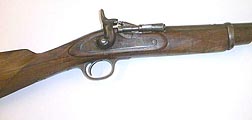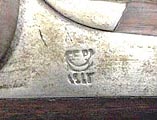
|
|
Russo-Turkish War of Liberation 1877-1878 Chapter Three - Small arms of the warring states - Ottoman empire "Snyder" The rifle system “Snyder” model 1865 was comparatively less used in the Turkish army. The Turkish units had about 325,000 rifles of this system.1 In Bulgaria, it was known as a “valve rifle”, probably because it had a valve breech-bolt. The Snyder rifle appeared when front-cartridge fire arms were being replaced. Therefore, the question came to the fore was related to the further use of large quantities of morally outdated weapons. Arms specialists and constructors from different countries focused their attention towards solving that question. Various plans for modifying the available front-cartridge rifles were drawn up. England also took part in these efforts. With their traditional sense, the English tradesmen understood that they could benefit from the emerging military conflict between Russia and Turkey. They considered the Turkish army as a potential buyer of modified weapons. A competition for modification of percussion rifles was set up in England in the 60s. The American Jacob Snyder won the contest. He had proposed comparatively simple but efficient way of using percussion fire arms. The modification was designed to cut off the rear part of the barrel and to install an additional bolt. An axle was mounted in its right-side part. A massive valve, turning to the right, moved around the axle. When pushed downwards, the valve closed the rear part of the cartridge chamber. There was a needle covered by a spiral spring. The valve stayed closed with the help of a small metal jut. There was a spring placed behind it. When closed, the jut went into a specially made slot of the valve and locked it in. A steel disk, which was immediately next to the valve axle, acted as an extractor of the empty cartridge case. The extraction was done by opening the valve and pulling it out in the farthest rear position. The extraction was easier if at the same time the barrel was lifted upwards. The rifle was loaded in horizontal position. The cartridge was placed in the cartridge chamber and was ready to fire when the valve was strongly turned to the left. In England, the Snyder breech bolt had undergone several improvements. Rifles produced by this method had a comparatively big caliber – 14.66 mm; their weight was no more than 3.8 kg, while the total length varied from 1030 to 1430 mm depending on their use.2 The firing speed was 9-11 shots per minute. Therefore, it was insufficient in comparison with Berdana and Winchester that had appeared at that time.3 The rifle was adjusted for unitary cartridges with a metal cartridge case and central fuse, which were created by Colonel Boxer. The bullet, type Minie, had a cone opening in its rear part. The cartridge weighed 48.3 g, and the bullet – 31 g. The black, fine grain gunpowder charge gave to the bullet an initial speed of 300-360 m/s. The method proposed by Snyder was approved in England in 1865. Other countries had shown interest in it soon after. For example, the method was taken over in France in 1867. It is curious to note that the French arms specialist Eugene Schneider worked on the Snyder breech bolt. The national media covered his contribution to the construction of the valve breech bolt. Some authors had been most probably influenced by this and had incorrectly referred to the Snyder rifle as “Schneider”. In France, it was recognized under the official name “Fusil Modele 1867 T”, but it had become known under the name “a latabatiere”. In his book “Fire Arms” Jaroslav Lugs refers to the French version of the Snyder rifle as “Tabatire”. In Denmark and the Netherlands, the modification of percussion guns after the Snyder method commenced in 1867. The United States had also produced rifles by this method, and some authors referred to them as “Springfield”. I am of the opinion that in this case it is not correct to link the name of the manufacturer4 with the name of the manufactured weapon. Moreover, some publications talk about the rifle models at random. For example, it is not possible to have a rifle Springfield model 1863 with a Snyder bolt as the Snyder method was officially approved in 1865. The reason for this inaccuracy is the stamp bearing the year of production of percussion rifles, which have afterwards undergone some modifications. As regards its qualities, Snyder can be compared only to rifles of the Krnka system.5 They should be equally evaluated. Reasons for this are the caliber which is almost the same, the analogous bolt construction, the similar qualities of ammunitions, and the similar main tactical and technical qualities.
|
Mannlicher ©2003-2004. All rights reserved. No part of this site can be reproduced in any way without the explicit permission of the authors.



